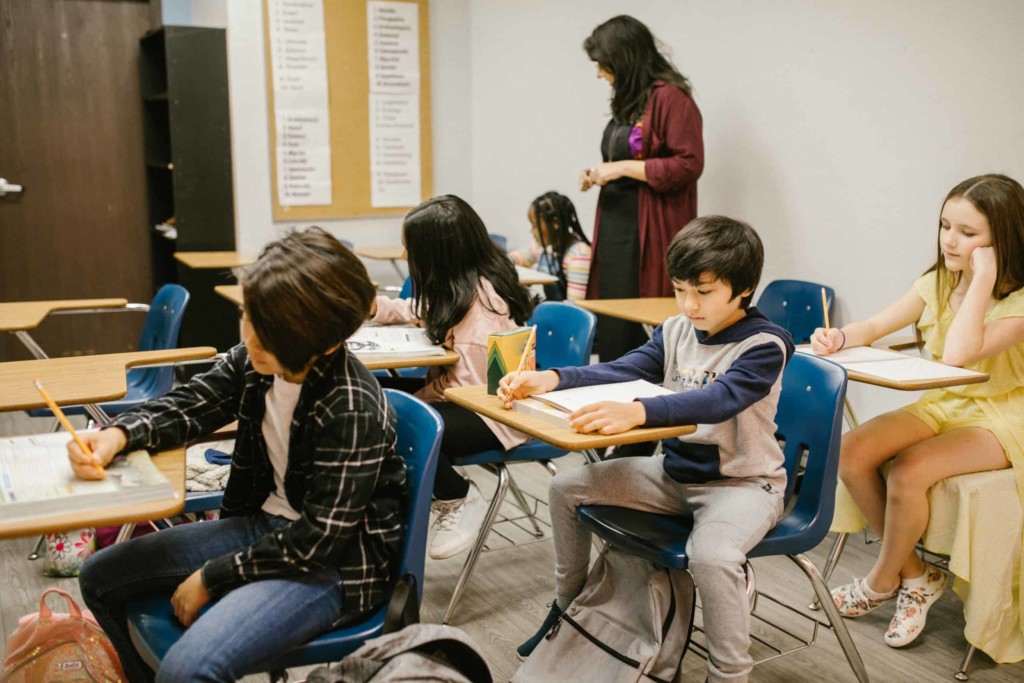How Monterey Peninsula Unified School District Reduced Their Failure Rate by over 60%

Two hours south of San Francisco, Superintendent PK Diffenbaugh and Assistant Superintendent Beth Wodecki have been working patiently and tirelessly with their team to reduce the failure rate of their students in Monterey Peninsula Unified School District (MPUSD). Currently, in his seventh year leading the district of 10,000+ students, Diffenbaugh was reviewing progress reports across the 23 schools in MPUSD back in the winter of 2020. He felt a moral obligation to address how 1,500 of the district’s students were on track to fail at least one course and have it permanently stamped on their transcripts. He looked to an initiative already underway in the district, revisiting the shift away from traditional grading policy components to one founded on a standards-based model that refocused student feedback on the mastery of competencies.
Though the onset of COVID-19 didn’t reveal the problem with students slipping and falling behind, it underscored the need for a proactive response. Diffenbaugh reviewed the reports forecasting these student failures and knew that continuing with the status quo wasn’t an option. Working with Wodecki, the two gathered a group of early adopter principals and teachers to begin drafting a strategy to improve chances for student success. “This is one area where we have tangible results — this is tangible change,” Wodecki said in support of a rapid shift away from traditional grading as a means to reducing the projected failure rate.
Employing distributive leadership, Wodecki charged her most enterprising teachers and principals to consider what a change in the district’s grading policies would do to turn the trend around. In spite of the urgency, Diffenbaugh and Wodecki were committed to avoiding a top-down mandate. There were teachers already vocal that they wanted a significantly more equitable approach to student feedback supported by the district than the traditional A-F grading scale in their schools. Diffenbaugh and Wodecki urged those frontrunner teachers to get specific about the problems with traditional grading and provide options for an alternative grading policy to begin a shift.
Traditional grading isn’t equitable—it’s just familiar.
MPUSD’s student body is predominantly Hispanic, and thus a high percentage of those students with failing grades on their progress reports were students of color. MPUSD felt traditional grading was overly penalizing and thus discouraging students who weren’t performing—that their policies weren’t equitable. Those learners at-risk for failing a class and most historically-underserved were most affected.
Wodecki’s cohort of teachers and principals set out to determine what the options were to reduce the number of Fs across the student body. What they found were familiar grading policy components that were having a negative impact regardless of intent. Some of these attributes were:
- The A-F/100-point scale
- The exponential weight of a zero in the gradebook
- Penalizing students for work turned in late
- Not allowing for makeup work
- Using low scores as discipline to prevent participating in other activities or privileges
They came to the conclusion that grading had become more about rewarding attempts and punishing inaction instead of offering high-quality, specific academic feedback on mastery of discrete concepts and skills. “If we have thousands of kids we’re going to fail in this pandemic, we are not putting them on a good trajectory for opportunity,” says Diffenbaugh.
Aligned with the evidence of assessment and feedback research from experts like Robert Marzano and Doug Reeves, Wodecki believes that a failing grade does not motivate most kids and, in fact, does harm to students’ self-worth and their perception of the school’s relevance to their lives. “We are doing a lot of harm,” she says, “It’s educational malpractice.” Each zero or failing assignment grade undermines engagement and advocacy. Diffenbaugh believes that if students fail at that rate on his watch, he’s failing as a leader of the district and has humbly made that known to staff and students alike.
District leaders and teachers united to put together an approach for a “do-no-harm” grading policy across the district and brought it to the board for their consent. It was unanimously approved for the remainder of the 2020-2021 school year and MPUSD could continue its strategic transition from traditional grading to a standards-based approach before the pandemic broke.
Confronting The Failure Rate
Given board approval, the district established working groups of standards-based grading early adopters along with their principals and assistant principals. The project team began sharing among their teammates the ideas for creating and adopting a no-harm grading policy. Leaders looked at legal abilities to make policy changes based on a crisis designation. The project became a mission for the team, sending them out into the community to meet with district families in order to increase family and community engagement. Diffenbaugh said, “We had to be making those home visits and setting up those super systems. We had to figure out—for each kid—why they aren’t being successful.” Likewise, the district invested in increasing mental health supports and using community-based referrals when diagnosis and deeper treatment were needed.
The MPUSD data team conducted a breakdown of the number of Fs by teacher and section and gave real-time data to school leadership. This enabled the leaders to have nuanced conversations about how the learning was progressing leading to a downward turn so they could tease out trends and plan interventions student by student. At one point, Diffenbaugh asked, “The kids are logging in, so how do we equate attendance with the magnitude of F’s?” Diffenbaugh’s point to his staff was that digital seat time is no more a corollary to student success than it was with in-person instruction, pre-pandemic.
Teachers were able to look at their gradebooks and, with their principals, get very specific about the variance they saw from adjacent classrooms teaching the same course or material. It started to become apparent to an increasing number of the MPUSD staff that they could afford students with failing grades an opportunity to catch up by proving they know the agreed upon competencies. Diffenbaugh challenged his principals asking, “If they can show you they know it now, why are we penalizing them for not knowing it two months ago?” This led to an agreement of students being able to put forward their last, best, and final assessments to move from failing to a passing grade. If the teacher agreed with these three artifacts of evidence, the student could move from an F to a passing grade of a D or better depending, and be removed from the failure report, and could begin a recovery with cohort support.
What emerged included switching to the standards-based gradebook from their vendor, Illuminate, publishing explanations of the standards-based approach, and the creation of an individual learning plan (ILP) for each of the students who were experiencing difficulties. Then, they were assigned a 14:1 cohort of fellow students with three or more incompletes on their report card. Seaside High School in particular needed significant support. They gathered four cohorts of students with failing grades and the district hired substitute teachers to help with each cohort and protect the intervention from stalling out. She and her educator team felt their struggle wasn’t only worth it, but that it paled in comparison to what their students were experiencing.
These shifts happened without a district mandate. The distributive leadership model empowered consensus-building and together the leaders decided the priority of setting up a program to prevent students from slipping even further behind. The goal was to set the student up with the precise supports needed to develop the agency to become successful on their own.
Outcomes & Takeaways
With successful results from changing grading in their own class sections, the early adopters recruited peer teachers and together changed their gradebooks and explained the new standards-based approach to their students and families ahead of the start of the 2019-2020 school year. When the pandemic broke, the early adopters expedited their grassroots evangelizing so that ahead of the 2020-2021 school year yet even more fellow teachers would be prepared to offer grading based on a standard. Now 80% of MPUSD teachers use the standards-based approach for explaining to students what is being measured on an assessment.
The failure rate at MPUSD dropped by 60% (from 1,500 F’s down to 500 F’s) since the first quarter progress report following the application of the 2020 spring semester’s do-no-harm policy, layered on top of the accelerating shift to standards-based grading, district-wide. More students are on a path towards academic success, and family engagement is significantly higher than before the shift.
Considering every educator wants to see their class or school failure rate as low as possible, there are a few keys to MPUSD’s progress thus far. They learned:
- When you see a problem in how students approach learning, invest in solving it.
- The permanence of the student’s transcript is a moral obligation of the educators contributing to it. Final grades deserve serious consideration.
- Grading policies aren’t sacrosanct and can be changed
- Having a data team with the capacity to provide real-time feedback to teachers and administrators is critical.
- Seek out Student Information System (SIS) and Learning Management System (LMS) that offer a quality standards-based gradebook or integrate seamlessly with third-party gradebooks that support standards-based grading.
Next Steps
Acknowledging that the effort to stem the failure rate required a lot of hard work and collaboration, MPUSD isn’t stopping. They’re motivated to see struggling students become more successful. A failure report that diminishes in time reinforces that their continuously improving interventions have boosted academic performance. This means increased opportunities for each MPUSD student to progress in their learner’s journey. The district is committed to seeing all MPUSD teachers adopt a standards-based grading model prioritizing mastery of competencies and personalize learning for every student. MPUSD is making a difference by providing a more equitable learning experience that sustains engagement and demonstrates care for students’ success without sacrificing rigor or standards.
For more, see:
- A Reliable Hybrid Learning Model: Cedar Rapids Schools Responds to Setbacks
- Organizing a Modern Edtech Stack for Modern Pedagogy, Part II: The LMS
- Organizing a Modern Edtech Stack for Modern Pedagogy, Part I: The SIS
Stay in-the-know with innovations in learning by signing up for the weekly Smart Update.






Donald Patrick Ray
As an MPUSD teacher for 38 years in Science and substituting after the bottom line is students in Continuation High School have progressively been given a “Pass” in terms of classroom work. The C grade is now 65 percent; suspensions are down to nothing allowing poor behaviors to go unpunished; everybody graduates even if they haven’t shown up for excessive days; teachers are encouraged to pass students; and State scores are abysmal as they are pretty much through the district.
I retired in 2012 when they quit doing Hands on science labs and also when they replaced alternative reading level based textbooks with 1200 page science books beyond their reading level.
My experience was teaching 6th grade Science Camp in Santa Cruz Mountains; K-6 Science Specialist to San Jose Unified; Science department Chairperson Jon Muir Middle School San Jose; and 38 years teaching; then Subbing for MPUSD. Have Life Science; Biology; and Geoscience credentials.
These changes in expectations do not benefit students or society in my humble opinion.